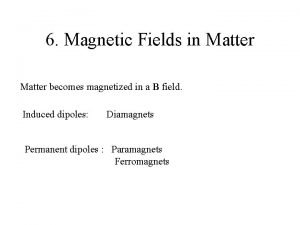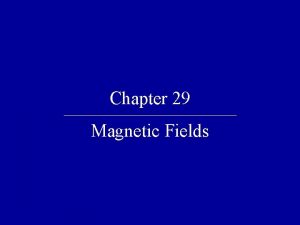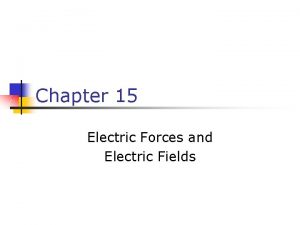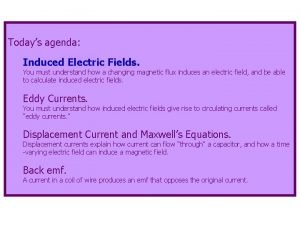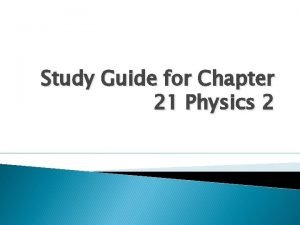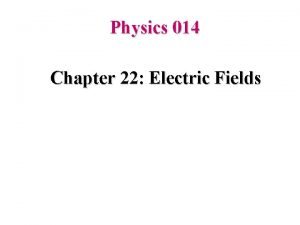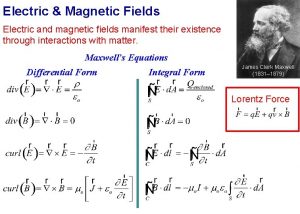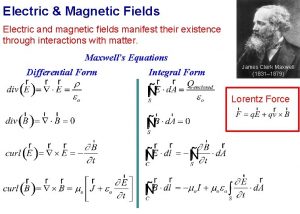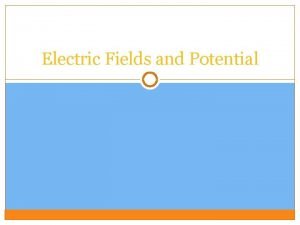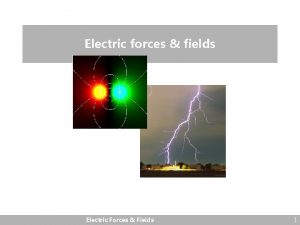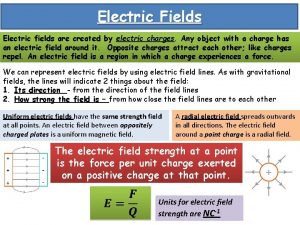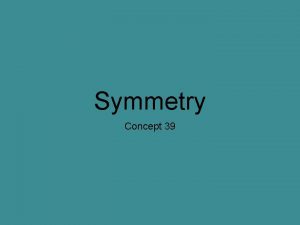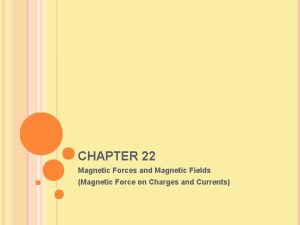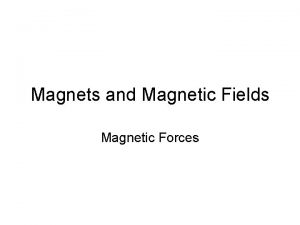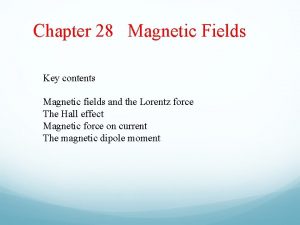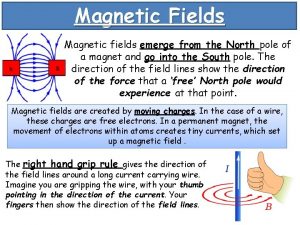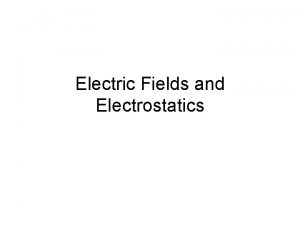Symmetry Concept Multipolar Electric and Magnetic Fields 1
















- Slides: 16

Symmetry Concept: Multipolar Electric and Magnetic Fields 1 Electric multipole moment Magnetic multipole moment Int Elm Rad Partial integration El. multipole moment unit = e×(length)ℓ , magn. multipole moment unit = µB×(length)ℓ− 1, e = elementary charge, µB = Bohr magneton. ∇ · B = 0 there are no magn. monopoles. Concept of magn. monopole useful in describing magn. features of composite objects Useful representation of spherical harmonics: zero or positive integers p, q, and s, with p + q + s = ℓ and p − q = m. W. Udo Schröder, 20018

Coulomb Fields of Finite Charge Distributions System states are typically not spherical in any state (different types of deformation). Excitations open further types of deformation (see later) z e arbitrary nuclear charge distribution with normalization |e|Z 2 q xis a try e m m sy Coulomb interaction system - e Int Elm Rad Details of shape are not “visible” at large distances. From distance, everything looks like a point charge. Expansion of « 1 W. Udo Schröder, 20018

Coulomb Fields of Finite Charge Distributions z Test Particle e Expansion of |e|Z 3 q x y a r t me Int Elm Rad m sy is for |x| « 1: Recovered “by accident” (? ) expansion of symmetric angular shape in terms of W. Udo Schröder, 20018

Multipole Expansion of Coulomb Interaction z e Different multipole shapes/ distributions have different spatial symmetries and ranges 4 q x y a r t me m sy Int Elm Rad W. Udo Schröder, 20018 is

Interactions of El Multipoles with Electric Fields Consider example of hydrogen atom in homogeneous external electro-static field E “Stark” perturbation (electronic charge e) z qd 5 q+ x En, ℓ (e. V) Int Elm Rad Stark Effect in Hydrogen W. Udo Schröder, 20018 2 nd order effect

Static Magnetic Fields Examples from solid state and nuclear physics Here: The cubic fluorite crystal structure of the An. O 2 compounds. Green spheres: actinide An ion, blue spheres: oxygen atoms. Int Elm Rad 6 M. -T. Suzuki, N. Magnani, and P. M. Oppeneer. Journal of the Physical Society of Japan (2018) Schematics of the splitting of the 14 one-electron f orbitals. Spin-orbit interactions splits the orbitals in j = 5/2 and j = 7/2 orbitals, which are further split by the cubic crystal field. The number in the brackets denotes the degeneracy of the orbitals ( M. -T. Suzuki, N. Magnani, and P. M. Oppeneer, Phys. Rev. B 88, 195146 (2013) ). W. Udo Schröder, 20018

Int Elm Rad 7 Multipole Magnetization Distributions W. Udo Schröder, 20018 Spatial distributions of the magnetic moment densities of (a) UO 2 and (b) Np. O 2, for two different viewing directions, [100] and [111], computed with U = 4 e. V and J = 0. 5 e. V. The magnetic moment distributions are depicted on the isosurfaces of the charge densities for the [111] component, with magnitudes as given by the color bars with µB unit. The thin lines show the contour map of the charge density on a spherical surface. M. -T. Suzuki, N. Magnani, and P. M. Oppeneer, Phys. Rev. B 88, 195146 (2013)

Magnetic Moment Interaction with Elm Field Particles with intrinsic spin angular momentum have magnetic dipole moment, always coaxial with spin (2 s+1) possible energy states. quantization axis ms ħ 8 z y f Int Elm Rad x Distill component of interaction Hamiltonian from part within parentheses. W. Udo Schröder, 20018

Magnetic Dipole Moments Moving charge e current density j vector potential A, influences particles at via magnetic field =0 Int Elm Rad 9 e, m current loop: W. Udo Schröder, 20018 m. Loop = j x A= current x Area

Magnetic Moments: Units and Scaling Magnetic moments: 10 m Nuclear Spins Units g factors g<0 m I W. Udo Schröder, 2011

Total Nucleon Magnetic Moment z Superposition of orbital and spin m: Nuclear Spins 11 below use these single-particle states Precession of m around z-axis slaved by precession of j all m components perp. to j vanish on average. W. Udo Schröder, 2011 maximum alignment of j

Effective g Factor Nuclear Spins 12 gj: effective g-factor Magnetic moment for entire nucleus: analogous definition for maximum alignment, slaved by nuclear spin I precession W. Udo Schröder, 2011

Magnetic e-Nucleus Interactions z Energy in homogeneous B-field || z axis 13 Force in inhomogeneous B-field || z axis Nuclear Spins Atomic electrons (currents) produce B-field at nucleus, aligned with total electronic spin Total spin W. Udo Schröder, 2011

Magnetic Hyper-Fine Interactions HF pattern depends on strength Bext 14 FS HFS Strong Bext breaks [J, I]F coupling. F import for weak Bext, independent for strong Bext weak Bext strong 1 s 2 p X-Ray Transition m. J electronic splitting Nuclear Spins 2 m. J -2 W. Udo Schröder, 2011 2 separated groups @ 2 I+1=4 lines. (F not good qu. #) E 1, Dm. J=0

Rabi Atomic/Molecular Beam Experiment (1938) Force on magnetic moment in inhomogeneous B-field ||z axis I. Rabi 1984 Alternating B gradients 15 homogeneous B Nuclear Spins A B RF coil Dm. I Magnet B compensates for effect of magnet A for a given m. I W. Udo Schröder, 2011 Aperture Transition induced

Parity Conservation and Central Potentials Expt: There are no atoms or nuclei with non-zero electrostatic dipole moment Int Elm Rad 16 Consequences for Hamiltonian with some average mean field Ui for particles i (electrons, nucleons, . . ): Average mean field for particles conserves p U= inversion invariant, e. g. , central potential W. Udo Schröder, 20018
 Electric currents and magnetic fields
Electric currents and magnetic fields Electric currents and magnetic fields
Electric currents and magnetic fields Electric forces and fields concept review
Electric forces and fields concept review Red fields to green fields
Red fields to green fields Learning: module 26: magnetic forces and fields
Learning: module 26: magnetic forces and fields Magnetism lesson outline answer key
Magnetism lesson outline answer key Chapter 16: electric forces and fields answers
Chapter 16: electric forces and fields answers Chapter 33 electric fields and potential
Chapter 33 electric fields and potential Magnetic field in matter
Magnetic field in matter Magnetic force quiz
Magnetic force quiz Electric fields quiz
Electric fields quiz Electric fields
Electric fields Electric fields
Electric fields Induced electric field of a solenoid
Induced electric field of a solenoid Physics chapter 21 study guide answers
Physics chapter 21 study guide answers Electric field for a disk
Electric field for a disk Neurona
Neurona








